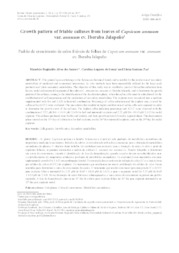Growth pattern of friable calluses from leaves of Capsicum annuum var. annuum cv. Iberaba Jalapeño.
Growth pattern of friable calluses from leaves of Capsicum annuum var. annuum cv. Iberaba Jalapeño.
Author(s): SANTOS, M. R. A. dos; SOUZA, C. A. de; PAZ, E. S.
Summary: The genus Capsicum belongs to the Solanaceae botanical family and is notable for the production of secondary metabolites of medicinal and economical importance. In vitro methods have been successfully utilized for the large scale production of plant secondary metabolites. The objective of this study was to establish a protocol for callus induction from leaves, nodal and internodal segments of the cultivar C. annuumvar. annuumcv. Iberaba Jalapeño, and to determine the growth pattern of the calluses, aiming at the identification of the deceleration phase, when the callus cells must be subcultured for the establishment of cell suspensions and the production of secondary metabolites. The explants were inoculated into a medium supplemented with BA and 2,4-D in factorial combination. Percentage of callus induction and the explant area covered by callus cells (ACCC) were evaluated. The procedures that resulted in higher proliferation of callus cells were repeated in order to determine the growth curve of the calluses. The highest callus induction percentage and ACCC were observed with the combination of 2.22 µM BA + 18.10 µM 2,4-D for leaf and internodal explants and 2.22 µM BA + 9.05 µM 2,4-D for nodal explants. The calluses produced were friable and whitish, and their growth pattern followed a sigmoid shape. The deceleration phase started on the 31st day of cultivation for leaf explants, on the 26th for internodal explants, and on the 29thday for nodal explants.
Publication year: 2017
Types of publication: Journal article
Unit: Embrapa Rondônia
Keywords: Callogenesis, Growth curve, secondary metabolites
Observation
Some of Embrapa's publications are published as ePub files. To read them, use or download one of the following free software options to your computer or mobile device. Android: Google Play Books; IOS: iBooks; Windows and Linux: Calibre.
Access other publications
Access the Agricultural Research Database (BDPA) to consult Embrapa's full library collection and records.
Visit Embrapa Bookstore to purchase books and other publications sold by Embrapa.

